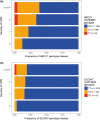Pharmacogenomics of Vincristine-Induced Peripheral Neuropathy Implicates Pharmacokinetic and Inherited Neuropathy Genes
- PMID: 29999516
- PMCID: PMC6519044
- DOI: 10.1002/cpt.1179
Pharmacogenomics of Vincristine-Induced Peripheral Neuropathy Implicates Pharmacokinetic and Inherited Neuropathy Genes
Abstract
Vincristine is an effective chemotherapeutic drug for various cancers, including acute lymphoblastic leukemia (ALL). Unfortunately, clinical utility is restricted by dose-limiting vincristine-induced peripheral neuropathies (VIPN). We sought to determine the association of VIPN with a recently identified risk variant, CEP72 rs924607, and drug absorption, distribution, metabolism, and excretion (ADME) gene variants in pediatric ALL. This was followed by a meta-analysis of pharmacogenomic data from over 500 patients. CEP72 rs924607 was significantly associated with VIPN (P = 0.02; odds ratio (OR) = 3.4). ADME analyses identified associations between VIPN and ABCC1 rs3784867 (P = 5.34 × 10-5 ; OR = 4.9), and SLC5A7 rs1013940 (P = 9.00 × 10-4 ; OR= 8.6); genes involved in vincristine transport and inherited neuropathies, respectively. Meta-analysis identified an association with a variant related to TTPA (rs10504361: P = 6.85 × 10-4 ; OR = 2.0), a heritable neuropathy-related gene. This study provides essential corroboratory evidence for CEP72 rs924607 and highlights the importance of drug transporter and inherited neuropathy genes in VIPN.
© 2018 The Authors Clinical Pharmacology & Therapeutics published by Wiley Periodicals, Inc. on behalf of American Society for Clinical Pharmacology and Therapeutics.
Conflict of interest statement
The authors declared no competing interests for this work.
Figures



Comment in
-
Pharmacogenomics of Vincristine-Induced Peripheral Neuropathy: Progress Continues.Clin Pharmacol Ther. 2019 Feb;105(2):315-317. doi: 10.1002/cpt.1209. Epub 2018 Sep 16. Clin Pharmacol Ther. 2019. PMID: 30277559 Free PMC article. No abstract available.
References
-
- Global Burden of Disease Cancer, C. et al Global, regional, and national cancer incidence, mortality, years of life lost, years lived with disability, and disability‐adjusted life‐years for 32 cancer groups, 1990 to 2015: a systematic analysis for the Global Burden of Disease Study. JAMA Oncol. 3, 524–548 (2017). - PMC - PubMed
-
- Gidding, C.E. , Kellie, S.J. , Kamps, W.A. & de Graaf, S.S. Vincristine revisited. Crit. Rev. Oncol. Hematol. 29, 267–287 (1999). - PubMed
-
- Gomber, S. , Dewan, P. & Chhonker, D. Vincristine induced neurotoxicity in cancer patients. Indian J. Pediatr. 77, 97–100 (2010). - PubMed
Publication types
MeSH terms
Substances
Grants and funding
LinkOut - more resources
Full Text Sources
Other Literature Sources
Medical
Molecular Biology Databases

